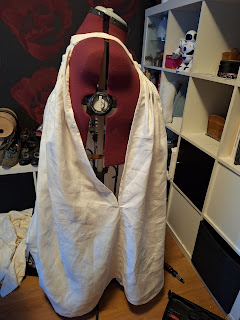Back when I made my 1520s court gown I was quite a lot into embroidery, and I wanted to make an embroidered hood, that was not as fancy as my embroidered gold hood. In 2021 the Royal Armory made a challenge to take an object from their collections and turn it into an embroidery for World Embroidery day in August of 2021.
One of their objects that I've always liked is this prayerbook, probably owned by Malin Sture, it's her family's coat of arms in the front and signed with by her siblings and cousins, she was cousin to the royal family. It is dated to the 1550s/1560s, so a bit later than my preferable time period, but I still took inspiration from the edge decorations and created a cross stitch pattern from it.
The photo above is dated to August 2021. I realized that I wouldn't finish it before the set date for the challenge, and since then it's been an ongoing project. I've packed it up with a plan to finish it, realized that I wouldn't do it and then I've packed it away again. It's also been a project that I've brought to our cosplay meets when I haven't had anything special to work on.
I had finsihed the bottom border just before Christmas 2022, but then I decided that it would look so much better if I doubled it, and then I packed the project away again. Finally I finished the whole embroidery in January 2024, only 2,5 years after I started it with a plan to have it done in a month or so.
I felt that the empty spaces in the middle of the pattern should have something, and I had two different sets of metallic spangles. The larger ones were to big, but I added a small metallic spangle all the way.
I finally had a finsihed embroidery, with some extra bling.
To protect the backside of the embroidery, both from wear and from my hair dye I added a strip of linen in the back. This can more easily be removed so that I can wash it if I need to.
Now came the rest of the challenge, and that was to remember how I had planned to make this project into a hood.
I draped it over my wulsthaube, and it looked pretty good, but I felt that it was too bulky in the middle back ,and the result was also quite poofy, and I want a sleeker look for this hood.
Marlein - 16th century wardrobe has posted about three different kind of hoods, I don't quite understand her explanations, but I used her photos as inspiration for a new try.
I did remove quite a lot of fabric at the back corners to get rid of the bulk. I also hemmed all the edges, both because the fabric had started to fray at the sides during the handling of it over the years and because it means that I don't have to worry about finished them afterwards. It makes it easier to work from the outside.
I folded the fabric double and sewed the first 5 cm of the curved edge together.
The back of the cap, which shows the 5 cm ceam, but it's open above that. I also made eyelets along the edge under the seam, to be able to tighten the hood.
Then I decided to make an experiment and starch the hood before pleating the back. I don't know if hoods were starched, but starch was used for frilled veils in the 14th century, and I like the look and feel of starched linen. It also repels dirt. I used a medium starch, and dipped the hood while holding the embroidered border, I tried to avoid getting starch on the embroidery and spangles.
After pressing the hood it was time to pleat the back.
Folding the extra fabric and pleating it down doesn't have a specific formula. I try to work from the middle and get it even. Personally I like the look of a few larger pleats better than a more and narrower pleats. Since there are so few images of the backside of these kinds of hoods I don't know what was most common back in the day. The fabric was tucked in under the sewn seam in the back and the pleats were tacked in place.
This is what the inside looks like. I pleated the fabric from the outside, so you can see that it got twisted on the inside, but the important thing is that it looks good on the outside.
The hood is held tight by threading a ribbon through the eyelets and pulling it all together. The ribbon is tucked under the embroidered border, and that border is closed with a pin in the back. I used a satin ribbon, but might switch to a linen or silk ribbon later, but I didn't have one at home.
So here are the facts.
What the item is: an embroidered hood
How it fits the challenge: I started it in 2021, and just finished it in 2024 after a lot of procrastination
Material: linen fabric, silk thread, metallic spangles
Pattern: My own
Year: 1540s
Notions: linen thread
How historically accurate is it? around 85%
Hours to complete: It's a UFO so way too many
First worn: At a dinner in January 2024 (making this post was also a UFO)
Total cost: $50



.jpg)






















